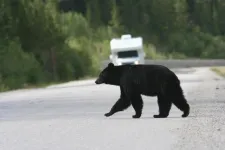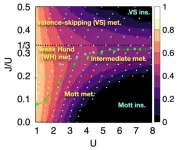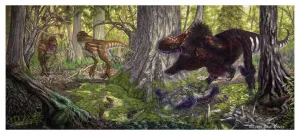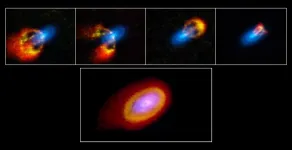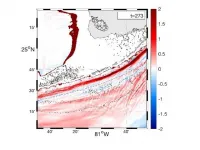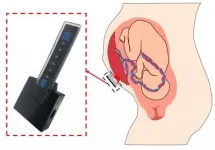(Press-News.org) Conservationists have long warned of the dangers associated with bears becoming habituated to life in urban areas. Yet, it appears the message hasn't gotten through to everyone.
News reports continue to cover seemingly similar situations -- a foraging bear enters a neighbourhood, easily finds high-value food and refuses to leave. The story often ends with conservation officers being forced to euthanize the animal for public safety purposes.
Now, a new study by sustainability researchers in the Irving K. Barber Faculty of Science uses computer modelling to look at the best strategies to reduce human-bear conflict.
"It happens all the time, and unfortunately, humans are almost always at fault," says study co-author Dr. Lael Parrott.
Looking to reduce the number of conflicts, Dr. Parrott and a team of researchers, including master's student Luke Crevier, built a computer model to simulate bears' journeys within a specific urban area.
Their goal was to find the best way to keep bears out.
Using the resort municipality of Whistler as their area of inquiry, the team partnered with Margo Supplies, a wildlife management technology solutions company based in High River, Alberta. Using agent-based computer modelling, researchers were able to simulate the movement of black bears in and around Whistler, identifying the potential attractants luring them in.
"Our model allows us to drop in large amounts of data, including the landscape's spatial characteristics, movement patterns collected from GPS tracking of real bears, and other important information to essentially create a virtual landscape," says Crevier.
The problem, he adds, is that bears are attracted to what researchers call anthropogenic food -- easily attainable food sources such as human garbage, berries or fruit.
"We were able to track the model bears as they moved through the landscape and interacted with different cells in the software that represented anthropogenic food, vegetation and human deterrents. The ability to input all of these proxies allowed us to better understand where they're roaming, why, and test different strategies within the simulation to find the most effective way to keep them out."
The study's findings reinforced the team's expectations that using attractant reduction and human deterrent strategies together was the most effective way to keep bears away. In cases where only one strategy could be applied, reducing attractants was the most effective.
"These results confirm that the most commonly used management strategies are indeed the most effective," explains Crevier. "What was really interesting was how the model allowed us to identify attractants that maybe otherwise wouldn't be considered -- like human garbage or large amounts of berries on private land within city limits."
A bear's intelligence and memory are largely the reasons why reducing the availability of anthropogenic food is considered more effective than reactive management strategies that aim to deter bears, when used alone.
"Using deterrents like bear bangers may be effective temporarily in that the bear will get frightened and run away, but they won't be gone for long," explains Dr. Parrott. "They'll remember being scared off, but their memories of the good meal will supersede their fear."
Though Whistler was selected as the study location because of the large number of black bears venturing into town, Crevier says this same type of modelling can be used for communities across Canada experiencing similar issues.
"What's cool about this model is it allows us to look at how different management strategies interact with each other, and this type of model can also be applied to better understand the movements of other large predators like cougars or wolves," he adds.
Dr. Parrott stresses it is important to learn how to co-exist with wildlife in a way that's safe for all -- including the animals. While some people may not think twice about a neighbourhood bear being destroyed, the practice has far-reaching implications.
"We know that bears who tend to come into communities are often juvenile or female bears with cubs, because the large males already have all the 'good spots' and have established their territories," she explains. "That's cause for concern because it means the females are teaching their cubs techniques to access anthropogenic food. It also means these are the bears who are most often put down, so we're selectively eliminating a particular part of their population.
The results of this study and similar agent-based models give conservationists another tool in the toolbox to help communities reduce the number of bears entering urban areas, ultimately reducing the number of bears destroyed, and putting the brakes on these problematic trends."
INFORMATION:
This study, recently published in Ecological Modelling, was funded by an engage grant from the Natural Sciences and Engineering Research Council of Canada.
Research shows that inhibiting necroptosis, a form of cell death, could be a novel therapeutic approach for treating chronic obstructive pulmonary disease (COPD), an inflammatory lung condition, also known as emphysema, that makes it difficult to breathe.
Published in the prestigious American Journal of Respiratory and Critical Care Medicine, the study by a team of Australian and Belgian researchers, revealed elevated levels of necroptosis in patients with COPD.
By inhibiting necroptosis activity, both in the lung tissue of COPD patients as well as ...
Electrons are ubiquitous among atoms, subatomic tokens of energy that can independently change how a system behaves--but they also can change each other. An international research collaboration found that collectively measuring electrons revealed unique and unanticipated findings. The researchers published their results on May 17 in Physical Review Letters.
"It is not feasible to obtain the solution just by tracing the behavior of each individual electron," said paper author Myung Joon Han, professor of physics at KAIST. "Instead, one should describe or track all the entangled electrons at once. This requires a clever way of treating this entanglement."
Professor Han and the researchers used a recently developed "many-particle" theory to account for the ...
New UMD study suggests that everywhere tyrannosaurs rose to dominance, their juveniles took over the ecological role of medium-sized carnivores
A new study shows that medium-sized predators all but disappeared late in dinosaur history wherever Tyrannosaurus rex and its close relatives rose to dominance. In those areas--lands that eventually became central Asia and Western North America--juvenile tyrannosaurs stepped in to fill the missing ecological niche previously held by other carnivores.
The research conducted by Thomas Holtz, a principal lecturer in ...
Like the movie version of Spider-Man who shoots spider webs from holes in his wrists, a little alpine plant has been found to eject cobweb-like threads from tiny holes in specialised cells on its leaves. It's these tiny holes that have taken plant scientists by surprise because puncturing the surface of a plant cell would normally cause it to explode like a water balloon.
The small perennial cushion-shaped plant with bright yellow flowers, Dionysia tapetodes, is in the primula family and naturally occurs in Turkmenistan and north-eastern Iran, and through the mountains of Afghanistan to the border of Pakistan. What makes it unusual is its leaves, which are covered in long silky fibres that ...
A team of scientists using the Atacama Large Millimeter/submillimeter Array (ALMA) to study the young star Elias 2-27 have confirmed that gravitational instabilities play a key role in planet formation, and have for the first time directly measured the mass of protoplanetary disks using gas velocity data, potentially unlocking one of the mysteries of planet formation. The results of the research are published today in two papers in The Astrophysical Journal.
Protoplanetary disks--planet-forming disks made of gas and dust that surround newly formed young stars--are ...
Ocean currents sometimes pinch off sections that create circular currents of water called "eddies." This "whirlpool" motion moves nutrients to the water's surface, playing a significant role in the health of the Florida Keys coral reef ecosystem.
Using a numerical model that simulates ocean currents, researchers from Florida Atlantic University's Harbor Branch Oceanographic Institute and collaborators from the Alfred-Wegener-Institute in Germany and the Institut Universitaire Europeen De La Mer/Laboratoire d'Océonographie Physique et Spatiale in France are shedding light on this important "motion of the ocean." They have conducted a first-of-its-kind study identifying ...
Researchers at the National Institutes of Health have developed a prototype device that could potentially diagnose pregnancy complications by monitoring the oxygen level of the placenta. The device sends near-infrared light through the pregnant person's abdomen to measure oxygen levels in the arterial and venous network in the placenta. The method was used to study anterior placenta, which is attached to the front wall of the uterus. The researchers described their results as promising but added that further study is needed before the device could be used routinely.
The small study was conducted by Amir Gandjbakhche, Ph.D., of the Section on Translational Biophotonics at NIH's Eunice Kennedy Shriver National Institute ...
People--who get lost easily in the extraordinary darkness of a tropical forest--have much to learn from a bee that can find its way home in conditions 10 times dimmer than starlight. Researchers at the Smithsonian Tropical Research Institute's (STRI) research station on Barro Colorado Island in Panama and the University of Lund in Sweden reveal that sweat bees (Megalopta genalis), find their way home based on patterns in the canopy overhead using dorsal vision. This first report of dorsal navigation in a flying insect, published in Current Biology, may be of special interest to makers of drones and other night-flying vehicles.
"One of the pioneers of studies on homing behaviors in bees was Charles H. Turner, an African-American scientist from the University ...
Bacteria do not sexually reproduce, but that does not stop them from exchanging genetic information as it evolves and adapts. During conjugal transfer, a bacterium can connect to another bacterium to pass along DNA and proteins. Escherichia coli bacteria, commonly called E. coli, can transfer at least one of these gene-containing plasmids to organisms across taxonomic kingdoms, including to fungi and protists. Now, researchers from Hiroshima University have a better understanding of this genetic hat trick, which has potential applications as a tool to promote desired characteristics or suppress harmful ones across genetic hosts.
They published their results on ...
Young people with poor mental health took a turn for the better during the pandemic but those with good mental health saw a considerable decline, new research reveals.
The first nationally representative evidence regarding the diverse impact of the COVID-19 pandemic on adolescent mental health in the UK was led by researchers at Lancaster University working with the University of British Columbia in Canada.
Adolescents (aged 10 to 16) with better than average mental health before the pandemic experienced an increase in their emotional and conduct problems, hyperactivity, and problems interacting with their peers and friends, but a decrease in their prosocial ...
